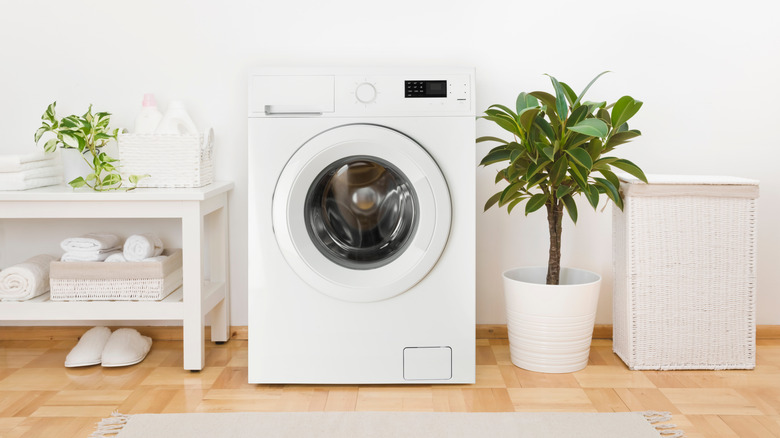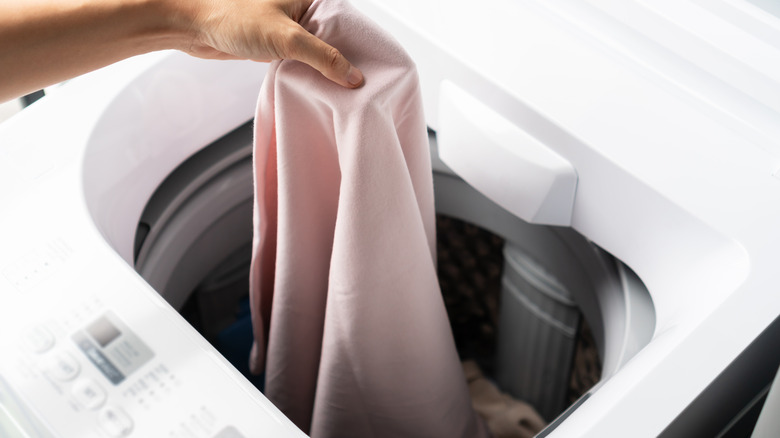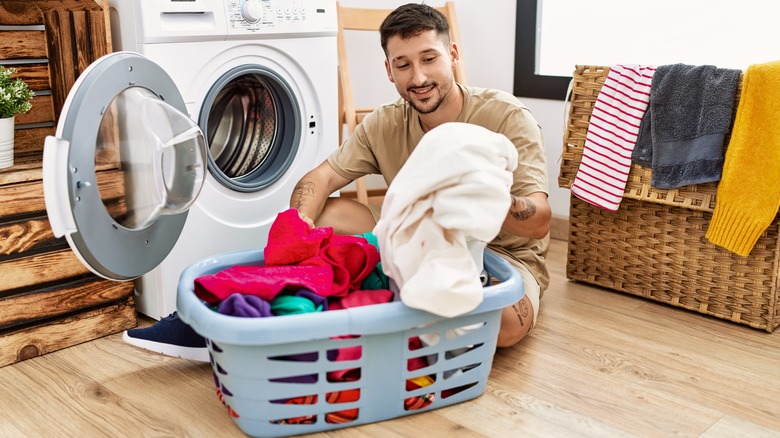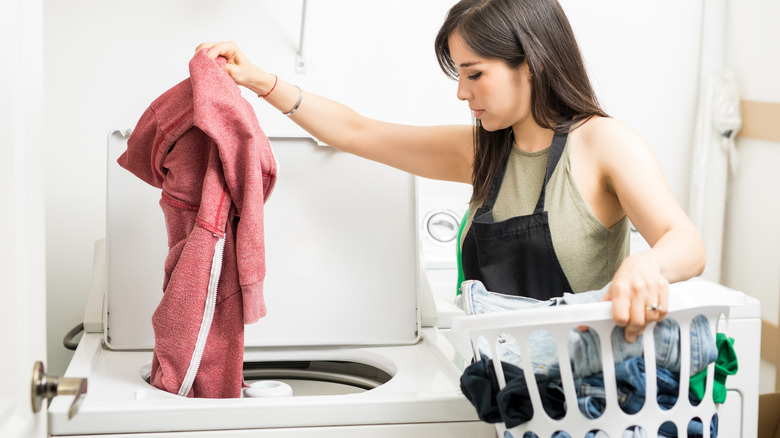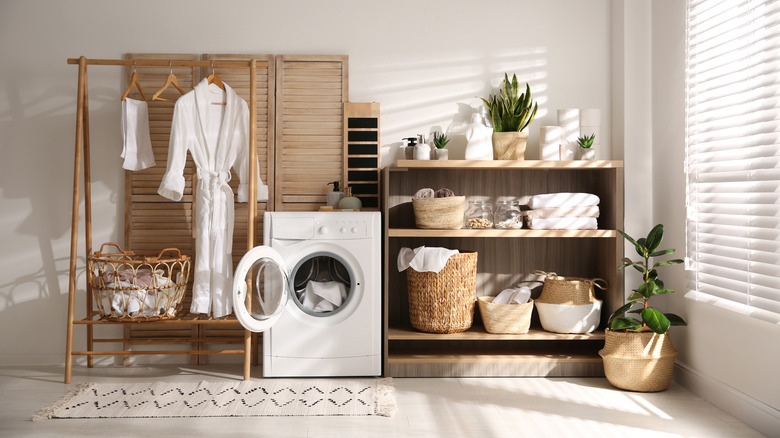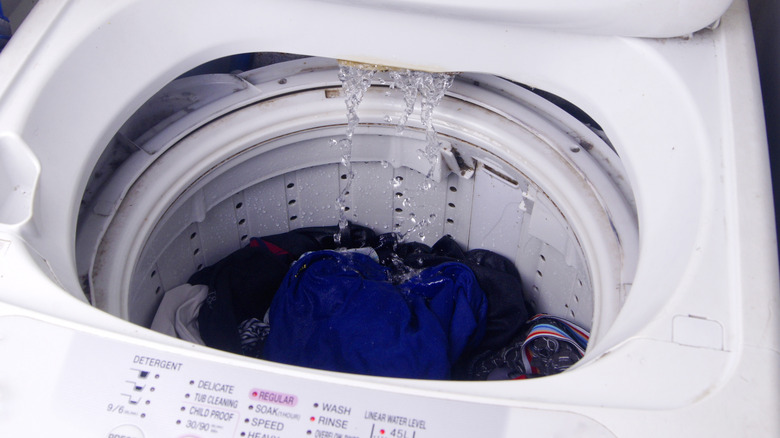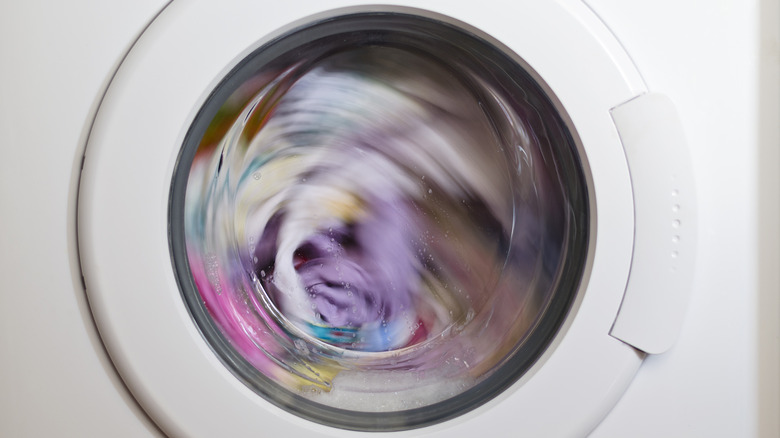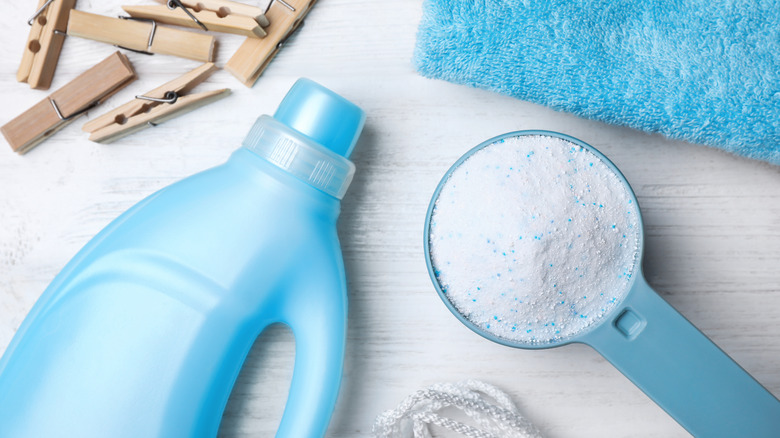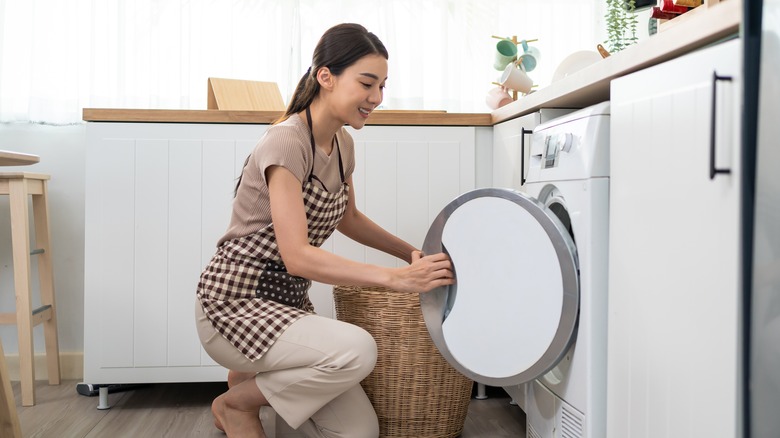Front-Load Vs. Top-Load Washers: Which Is Right For Your Home?
We may receive a commission on purchases made from links.
From size and design to energy efficiency and your budget, there are so many factors to keep in mind when it comes time to buy a new washing machine or replace your existing unit. Luckily, it'll be easy to tell when it's that time. A machine that is persistently leaky or overly noisy even after maintenance might be a sign that an upgrade is needed, according to CNET. Other potential issues include odors that just won't go away (particularly in older front-loading models) and an inefficient machine when it comes to energy usage.
If you're shopping around for a new washing machine, you're not alone. The global market for this household staple was estimated at $52.8 billion in 2020 (as reported by Fortune Business Insights). And it's expected to grow to $80 billion by 2028. Factors driving this boom include global urbanization, an uptick in sports participation (resulting in increases in loads of laundry), and the growth of the fashion and apparel industry.
When you're sure it's time to get a new washing machine, whether you're buying your first unit or replacing an energy-guzzling or worn-out machine, you might find yourself overwhelmed by all of the available options. But really, it all comes down to a question of type: front-load or top-load. How can you be sure which is right for your home? Let's dig into the major differences so you can shop with confidence and know that you're getting the best appliance for your needs.
Traditional top-loading washers are bestsellers but can cause wear and tear
A traditional top-load washing machine has a streamlined, classic look, with bare sides and some kind of control panel atop the machine. Clothing, bedding, towels, and other washables are put into it via a door on top, hence the "top-loading" moniker. This type of washer uses what is called an "agitator" to do the washing function during the cleaning cycle. It appears to be like an arm reaching up the middle from the base of the machine.
While traditional top-loading washing machines generally have pretty basic options in terms of wash cycle customization, they are the biggest sellers in the market. In 2022, Consumer Reports noted that these workhorse machines have remained the most popular in terms of sales even as more advanced models have arrived on the scene. "Top-load agitator washing machines aren't the most technologically innovative, but they continue to outsell front-loaders and even HE top-loaders, the kind without a center-post agitator," the nonprofit consumer organization stated. "According to the Association of Home Appliance Manufacturers, 44 percent of all washer shipments in 2020 were top-load agitators."
Despite their popularity, top-loading machines can cause increased damage to laundry loads due to the central agitator. Putting too many items into this type of machine can result in things like buttons and zippers being rubbed more aggressively against all the other pieces being washed, producing more snags and tears on garments than other types of washers (as reported by Sears Home Services).
Front-load washers are gentler on clothes
Front-load washing machines have an instantly recognizable look. A see-through, round door sits on the front of these machines and provides users with the opportunity to watch the wash cycle as it's happening. This type of washing machine does not have a central agitator for washing like traditional top-loading machines do. A front-load washer uses the movement of its own tub and water to stir and wash what's inside, according to Don's Appliances, a retailer based in the Pittsburgh, Pennsylvania, area.
Because of this, front-loading washing machines are generally gentler on what you're washing (as highlighted by Consumer Reports in 2022). Notably, some newer high-efficiency washing machines that are top-loading also do not have an agitator in them (as major appliance manufacturer Maytag notes on their website). Instead, these machines employ an impeller, a kind of fan-like disc, to spin the clothes.
Though front-loaders will keep your clothes and other washable pieces looking newer longer, they still represent a relatively smaller portion of the washing machine market. Consumer Reports (CR) also pointed out in 2022 that front-load washing machines accounted for only about 28 percent of all washing machines sent to retail stores in 2020. They got their data from the Association of Home Appliance Manufacturers and shared that the percentage was "a marked drop from the 38 percent shipped in 2009. By comparison, 44 percent of shipped washers were top-load agitators and 28 percent were high-efficiency top loaders."
Top-load washing machines are generally larger and have a sleek design
Traditional top-load washers have a classic yet basic look. They're most often white and have a door on top for loading laundry, in addition to a control panel with usually a single knob or multiples for running the machine. If you're in the market for a new top-loader, design is one thing to think about. As the blog Designer Appliances noted in 2022, top-load machines are not the most stylish or modern-looking. Still, if you're looking for sleek, no-fuss appliances in your home, top-loaders fit the bill.
Size and placement, as well as the overall layout of your laundry room, are also critical factors to think about when buying a new washing machine. Is it going in a tight spot? Where might it need to be placed so you can most easily get clothes in and out of it? Will the washer be in an open area and need to blend in visually with its surroundings? The standard size of a top-loader is 27 inches wide by 42 to 44 inches tall (according to appliance manufacturer Whirlpool). Depth is around 27 to 28 inches. You'll also need to have room for the machine's hoses and ventilation and to open the door to the tub. Whirlpool recommends two feet.
If you've got a particularly small space to do laundry in, get creative! Installing a fold-down rack that can serve as a makeshift folding or ironing board is one ingenious idea (as relayed by Spencers TV & Appliance, an Arizona chain).
Front-load washers are typically smaller with a more modern design
There's must-see TV, and then there's must-see washing. Well, it's an option at least with a front-loading washer. These models have a round, see-through window on the loading door that, once shut, allows you to watch your clothes as they're washed, if you're so inclined. For those with mobility issues, this type of washer, if raised up as needed, may be the way to go. Colors range from silver and white to even champagne and black, and as detailed by the blog Designer Appliances in 2022, front-loaders are designed with the most modern features compared to other types of washers.
Size-wise, front-loaders offer the most versatility. They can be either compact, full-size, or mega-capacity. Compact front-loaders generally have a width of about 24 inches, while mega-capacity machines can be up to 30 inches wide (as shared in 2021 by Grand Appliance and TV, a retailer with locations in the north-central United States). Heights range from 34 to 42 inches, with depths of 24 inches to 34 inches when the loading door is closed.
Especially appealing for some homes is that front-loaders can be stacked under or on top of a dryer unit. You'll need height space for the stacking, but in the end, it's a space saver in terms of square footage. And, given the variation in model sizes, some front-loaders can fit under countertops (according to K!TCHN Mag, a digital design and lifestyle publication), making for unique laundry room design opportunities.
Traditional top-load washing machines use lots of water
The US Environmental Protection Agency reports that 40 American states will likely experience water shortages by 2024. For those looking to do their part in water conservation efforts, seeking out efficient water-utilizing appliances is one step to take. When it comes to washing machines, heavily reliant on using water, this is especially true. Traditional top-load washing machines are the most water-hungry washing machines on the market. Appliance manufacturer Maytag notes that top-loaders that are not high-efficiency models can use upwards of 19 or more gallons of water per load of laundry (via their website).
And it's not just the water usage that is costly both for the environment and your budget. The top-loader's water demands will also add to your power bill if you select the heating option for the wash cycle. The majority of the cost of using a washing machine comes from heating the water that goes into it. There's another potential drawback too, in that traditional, non-high-efficiency top-loaders "have slower spin cycles than front-load machines. They can leave a gallon to two gallons of water in a load of laundry. If you don't line dry your clothes, that water has to be extracted in the dryer, which means a longer drying cycle (more energy waste) and more wear and tear on the dryer, too" (according to HowStuffWorks).
Front-load washers are the more water-efficient option
Compared to traditional top-loading washing machines, front-loading washing machines are incredibly water-efficient. As relayed by Consumer Reports in 2017, a front-load washing machine can use as little as seven gallons of water per laundry load, while top-loading washing machines can use upwards of 19 or more gallons. A front-loading washing machine in your home will be both eco-friendly in terms of water conservation and budget-friendly in reducing your monthly water bill.
The United States government-sponsored ENERGY STAR program reports that front-loading washing machines are estimated to be 25 percent more water-efficient (via the program's website). More people switching to front-load washers would result in enormous energy savings, according to Energy Star: "There are about 59 million top-load clothes washers that are in use today in the U.S. If those were replaced with front load washers, we would save about 14.9 billion kWh of energy and 170 billion gallons of water EVERY YEAR. The energy that could be saved is equivalent to the electricity used by approximately 1.3 million homes annually."
If you're worried that your clothes and other laundry items will not be sufficiently cleaned in a machine using less water, there's no need to fret. That is a common misconception. A Samsung front-load washing machine, for instance, uses about 13 gallons of water per cycle and pushes the water through what's in the tub rather than the other way around (as Samsung Canada states on their website).
Detergent types vary for high-efficiency vs. non-high-efficiency washing machines
The laundry detergent market is a multibillion-dollar business. Statista, a market and consumer data firm, shared on their website in 2022 that sales in dollars of laundry detergent in the United States was estimated to be around $5.87 billion in 2021. Liquid detergent makes up most of those sales, followed by packet or bar detergents and then powder varieties.
Though there are so many laundry detergent options to choose from, if you have a high-efficiency (HE) washer (an HE top-loader or any front-loading washing machine), you'll need to be sure to purchase specially formulated HE detergent (as home warranty firm American Home Shield notes on their website). This will be marked on the detergent's packaging. Using a detergent not designed for HE machines will result in an excess of suds and can cause damage to these kinds of washers in the long run.
To make sure the detergent you're using is cleaning your clothes effectively, American Home Shield cautions against overfilling your washing machine. In addition to ultimately producing more wrinkles on your items, overstuffing your washing machine can keep the detergent you're using from distributing evenly.
Electricity usage varies greatly in front-load washers vs. top-load units
Energy efficiency is an important factor to consider when you're in the market for any new appliance for your home. In addition to being better for the environment, an appliance that uses less power more efficiently will save you money over time. With washing machines, the difference in energy usage between front-loading machines and top-loading machines is pronounced.
According to the United States government's Energy Star program, a front-load washing machine uses 45 percent less energy than a standard top-loader. To save even more money, opt for cold water during the wash cycle, increase the spin speed, and skip the sanitary cycle option whenever you can (as Consumer Reports advised in 2021).
The energy-saving benefits of a front-loading washing machine extend also to your dryer. As the Energy Star program notes, "Front load washers help save on drying time and energy by spinning clothes much faster than top load washers to extract more water out of clothes." And, a front-loader can fit more items at once, reducing the number of loads that you need to do. An even more eco-friendly bonus? A front-load washing machine's wash cycle is gentler overall on clothes compared to top-load machines, so fewer microfibers and microplastics (from synthetic fabrics like polyester and nylon) get wrung out and make their way into the water system.
Traditional top-load washing machines are cheaper than front-loaders
Cost is usually one of the biggest, if not the biggest, factor for most people when shopping for a new appliance for the home. With one as large and frequently used as a washing machine, you want to be sure you're buying a reliable product and getting the most out of your money. Generally speaking, traditional top-loading washing machines are going to be the less expensive option compared to other types. A CNET roundup in 2022 of the best washing machines included a top-loader for as low as $515. Its best front-loader ranged from $855 to $945. But as you start to shop around, you'll probably hear that front-loaders will save you money in the end.
While the initial cost of a front-load washing machine is typically higher than a top-load model, the advanced features and energy-saving functions of a front-loader will translate to you spending less over time. A front-load washing machine uses less water and energy than top-loading machines, reducing your monthly bills (as HowStuffWorks reports). Because they're gentler on the items you're washing, that will translate into longer lives for your clothes and other washable pieces.
Given that front-load washers have more technologically complex mechanisms and features, it can be more expensive to have them repaired if something goes wrong. Employing a DIY fix for these machines may also prove to be more difficult than with a top-load washing machine.
Top-load washing machines typically outlast front-load machines by a few years
A new washing machine is a significant investment for your home. According to Sears Home Services, washing machines last for about 10 to 13 years, and in general, top-load washing machines outlive their front-load counterparts by "a few years." To extend the functionality of any type of washer, Sears recommends cleaning your washing machine's interior tub of the appliance with bleach to get rid of excess amounts of buildup or smells and using vinegar to dissolve any lingering suds.
Front-load washing machines are more prone to things like the development of mold and mildew (as detailed by Consumer Reports [CR] in 2022), particularly in the machine's dispensers and "the rubber gasket around the opening." Because this type of washing machine has more advanced features, increased repair costs are something to keep in mind. To keep on top of any mold or mildew issues, CR encourages front-load owners to "dry the inside of the door and the rubber gasket, carefully pulling it back to clean away residue" after finishing their laundry. They also recommend that owners of front-load washing machines "open the dispensers to give them a chance to dry" in between loads of laundry, and when you can, leave the door to the washer open so the interior can thoroughly dry out.
